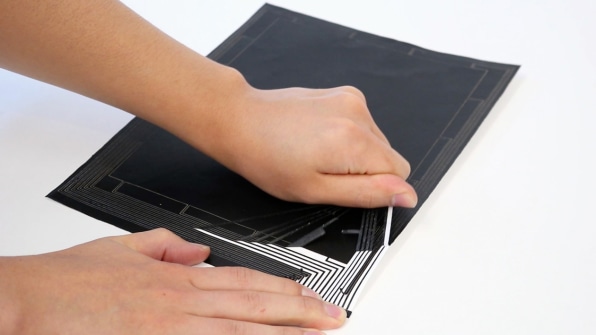How to Turn Off Touch Screen on Phone
In a world of smart stuff, there are still plenty of everyday items that are dumb. What would it look like if a piece of paper could become an interface without losing one of its essential characteristics–being cheap enough to throw away? What would happen to our homes if walls functioned as giant touch screens at a reasonable price?
Those are the questions behind two new projects out of Carnegie Mellon's Future Interfaces Group, presented this week at the ACM CHI conference focused on human-computer interaction. One project, cheekily called "Pulp Nonfiction," pioneers a new, inexpensive way of giving paper the ability to track your finger, pen, or other writing device–and the system, not counting a reusable set of electronics, only costs 30¢ per sheet. The other, entitled "Wall++" and done in collaboration with Disney Research, similarly imbues a plain old wall with touch screen-like properties using a relatively cheap painting technique that costs about $20 for about 10.75 square feet. While that's more than your average coat of paint, it's a lot less than the cost of a screen that size.
Here's how the team, led by professor Chris Harrison, did it: To turn paper into a smart sensor that can detect what someone writes on it, they coated the backs of paper sheets with conductive plastic film or carbon-loaded paint–both of which could be laminated or printed onto the paper when it's being produced. Then, sensors are added around the outside of the paper. The researchers' first prototype had a ring of copper stickers around the edge of a page that were individually hooked up to wires, but they soon graduated to silk-screening conductive material on the sheet's edges. Then, they could connect any sheet to a reusable sensor board powered by a computer.
The sheet is able to sense your finger because of 16 conductive nodes around the edge of the paper, each of which emits a tiny wave of current throughout the sheet that the rest of the nodes measure, essentially forming a mesh of measurements. Then, when the current is disrupted (i.e., you start drawing on it), the computer can figure out exactly where.

What could this be used for? One possible use is interactive education: For instance, you could have a multiple choice paper test that is graded in real time, because the system knows what you answer as you answer it. Another is to bring some interactivity back to print newspapers or magazines: Imagine having a "share" or "read later" button on your newspaper; when you press it, the paper automatically tweets or saves the story for you. The paper could also be used in notebooks or even sticky notes–every sticky note from a brainstorming session could be automatically digitized for future reference. The key to all these applications for the researchers is that the paper is low-cost, which allows for one-time uses and preserves what makes paper unique as a medium while augmenting it.
There's a similar idea behind Wall++: When you can do something cheaply enough, you have a better chance of making it ubiquitous. Walls are already everywhere, but they're largely underused, their function limited to dividing spaces and hiding infrastructure. But Harrison's team, in collaboration with Disney Research, set out to find a way to augment walls cheaply without needing special materials. The result? A wall treatment where diamond-patterned conductive paint is paired with copper tape. These layers sit invisibly beneath a top coat that makes the wall blend in. If you looked at it, you'd just see a wall. The only hint that something's different might be the small group of circuit boards that are connected to the wall.
The wall, once finished, works something like a smartphone touch screen. In essence, when you touch one of the sensors embedded in the wall, your body interferes with that sensor's electric field–which can be measured. In this way, the researchers' wall can detect where it's touched, and, if you're close enough, it can even sense the pose you're standing in. The walls are also able to sense the electromagnetic noise given off by appliances, a feature taken from one of the group's previous research projects.
These features basically transform a wall into an interface. Touching a particular spot might turn on your lights or your television, or you could tap out a certain pattern to unlock a door. Because it can detect poses, it could also act as a controller for games.
Both projects point to a daring vision of interfaces: Where you don't have to look at a screen to access the power of computers.
How to Turn Off Touch Screen on Phone
Source: https://www.fastcompany.com/90168954/turn-your-wall-into-a-touchscreen-for-20